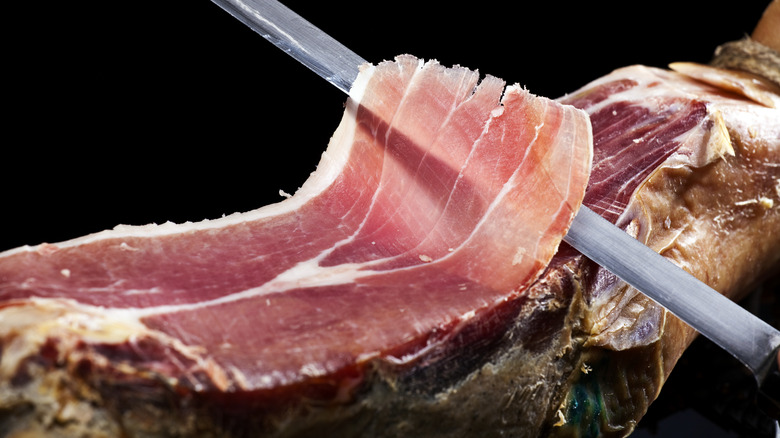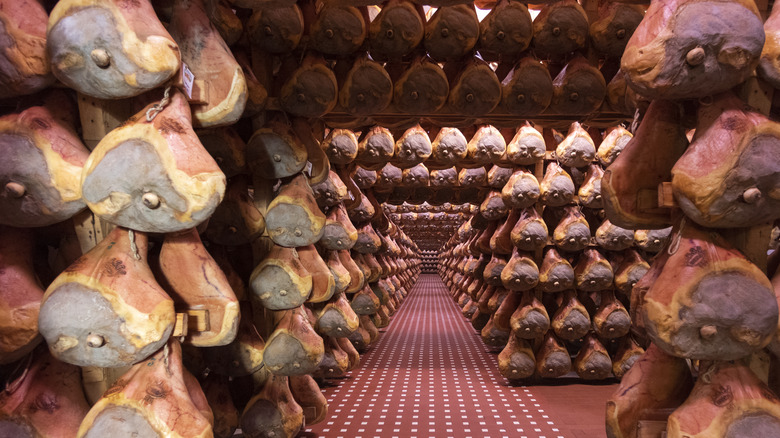How Long Is Prosciutto Typically Aged For?
If you're ever in Italy and decide to ask for some prosciutto from the source, you may not get exactly what you expect. In Italian, prosciutto is the catch-all term for ham, not necessarily the savory and thinly sliced meat you're used to seeing. What you're looking for is prosciutto crudo, and no one does it better than where the delicious pork product came from.
Hailing from Italy long ago, prosciutto crudo stands apart as one of the most delectable tastes known to man because of how much time is devoted to turning the hind leg of a pig into a salty delicacy. The aging process, in particular, has no equal. Salted to perfection, prosciutto can take anywhere from 14 to 36 months to reach maturation. And if you think that is a long time to devote to anything, just ask any painter or novelist how long is too long to devote to your art. The final product should be enough to convert anyone to support such an endeavor. Whether eating it on its own or using it to make Ina Garten's turkey meatballs, prosciutto is the perfect final touch for any occasion.
The prosciutto curing process
Aging the protein is just one part of the process that makes this meat treat so tasty. Butchers have an entire routine that contributes to the success of prosciutto. It all starts in Italy with the selection of high-quality pork legs. Then comes the critical curing process necessary to make the meat safe to consume.
We all know that, while technically raw, prosciutto is safe to eat, but how exactly does that work? Few select foods fall into the category of safe to eat. Sushi or smoked meats are some of the more popular raw fare, but other foods don't have the same leeway. Curing the pork is extremely important to ensure food is safe to eat. The process starts before the meat is even butchered. Pigs are specifically bred to become prosciutto in Italian provinces. Producers cure the meat by salting it, which draws out excess blood and moisture. Salt is the main component that stops any harmful elements from arising. Meat goes bad because of bacteria growth, and salt helps prevent that from occurring. So even though the meat is raw, it results in an irresistible pork product. After the months-long aging process concludes and the meat has finished curing, it is time to slice. Prosciutto should be sliced so paper thin that you can see through it. Then, the delectable morsel is ready for whatever innovative dishes at-home cooks see fit.
The secret ingredient to making prosciutto
If you are on an elevated pork kick and want to dabble in curing meat yourself, there is a downside. Making prosciutto isn't just about the specific steps of aging and curing. The melt-in-your-mouth salty ham doesn't depend on how to make prosciutto but where; a specific step cannot be overlooked during the production phase. The salting process includes physically salting the meat and allowing the ocean breeze to flavor the pork.
San Daniele del Friuli is one of the Italian towns that produces prosciutto. There, producers keep the windows open in a temperature-controlled room so the mountain air from the outside also seasons the meat. Prosciutto di Parma is another respected brand that seasons its meat with the breezes from Parma, Italy. There is, of course, the American stuff that will do in a pinch. Grocery stores can sell prosciutto that has been cured and sliced in places other than Italy. But these are experts in the field, and there is nothing like the local stuff.


